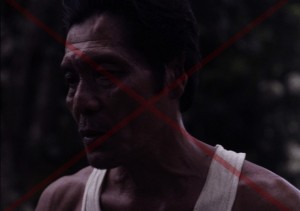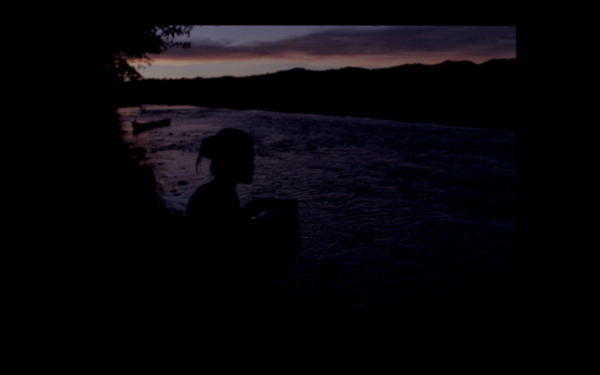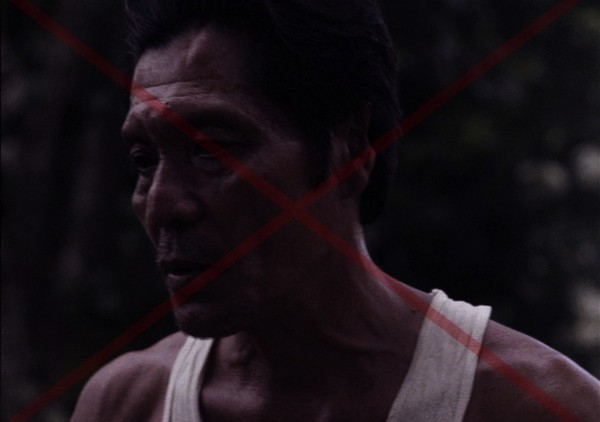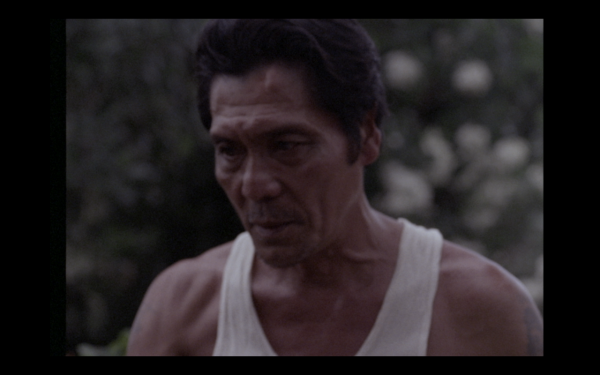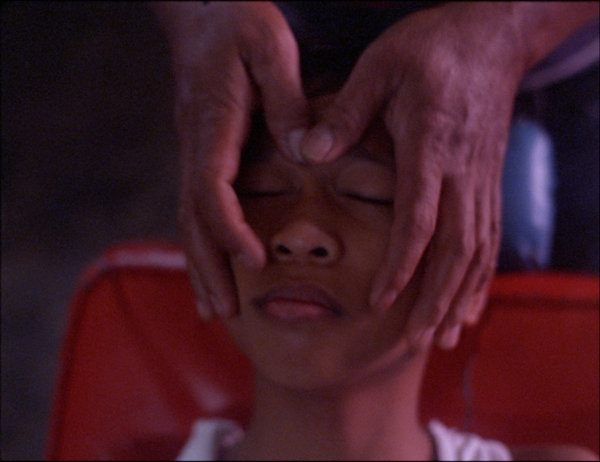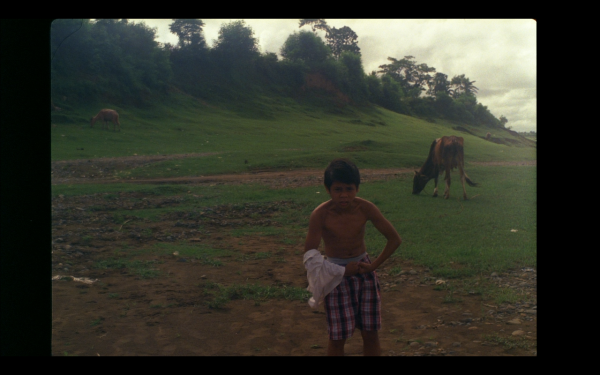-
Lost and Found: John Torres Discusses Lukas the Strange
by Aaron Cutler July 9, 2013
“Lukas, in the middle of the film, the actress will pay a visit. You’ll fall in love with her. And you’ll understand your father. I’ll become your memory. I haven’t shown you the middle yet.”
The words are spoken by a female voice over a black screen at the start of Lukas the Strange (2013). They make a promise while longing for a connection. It’s unclear who both this woman and Lukas are, though she leaves the sense that whatever distance exists between them will be difficult to breach. As the film continues, the voice promises to tell more about what happened—why a man left his family, why a woman grew so sad, and what was in the box that she threw into the “river of forgetting” that encircles the village. “These are things that need telling,” she says out loud, and then wonders, “But how can I tell Lukas without him forgetting?”
In all of the Filipino filmmaker John Torres’ films, stories exist to fill a void that lost memories have left, and throughout them all, the fear lingers that the void will remain. For the rural community in which his fourth feature film unfolds, a void exists in the form of an actress who’s disappeared from the film shoot underway there; for Lukas, a void also exists in the form of his father, who tells the 13 year-old, “Son, I am a tikbalang” before abandoning him. A tikbalang is a creature from Filipino folklore—half-man, half-horse. Lukas goes on to wonder whether he himself will grow up to be one then, as he dons a helmet to play a tikbalang in his town’s film shoot and casts himself in the image of a departed loved one.
Torres (who was born in Manila in 1975) had previously recalled lost loved ones in his second feature, Years When I Was a Child Outside (2008), which recreated his experience of having been separated from his father when he was young. Actors present a version of his family history, with Torres himself narrating from offscreen to “You,” creating the impression of a man reaching out to his younger self. This differed from how Torres had told his own story in the first-person in three early shorts that the critic Alexis Tioseco collectively labeled the “Love Films,” which circled around a longtime love relationship’s end. Yet even though their modes of address differed, the films shared the same impulse: to ease pain through storytelling.
Lukas the Strange, which received its world premiere at this year’s International Film Festival Rotterdam, also does this. Lukas is not just the first film work by an artist who has previously shot exclusively in video, but an overtly retrograde film in its recollection of earlier tales. Early on, brief deteriorated images appear of a young woman walking past villagers, including a young boy. These images, taken from the director Ishmael Bernal’s 1974 film My Husband, Your Lover, offer a prelude to a new work made with the grainy, occasionally flaring visuals and dubbed sound of Filipino films from the 1970s and 1980s. In drawing on this period, Lukas the Strange also invokes the years of the Philippines’ military dictatorship, during which a number of political dissidents were murdered before the military gave way in 1986 to corrupt, neocolonial democracy. As Lukas reenacts the role of his father, the present calls upon memory to help it fight absence and silence; at the same time, the film suggests the pain of remembering to be so great that some forgetting is needed. Like Torres’s other films, Lukas the Strange looks for the middle.
Tell me about Lukas the Strange, or Lukas Nino, as the film is titled in Tagalog. Is the English-language title a direct translation?
The title was supposed to be Lukas Niño [“Lukas Child”]. I was so lazy not to type in the “ñ,” so it became “Lukas Nino.” And “nino” in Tagalog means “whose.” So whose Lukas is this? Does he belong to creatures or to men?
Tell me about how you came up with it.
Man, that’s a hard question. Why do you ask me this?
Well, where did the film come from?
OK. Prepare. I’m going to try to make it really short. I have this film hero, the Filipino director Ishmael Bernal, who’s a contemporary of the better-known Lino Brocka. When festivals think Filipino cinema in the 1980s and 1990s, it’s Lino Brocka, but there’s this equally wonderful filmmaker, Ishmael Bernal, who made his most famous works around the same time. Bernal’s films have a subdued quality to them, a little dream-like, with many things that are unsaid but that you can feel nonetheless, things that are there if you look for them. He has a filmography of 40 films. Around the 15th or 16th title, there’s a lost film. It’s called Scotch on the Rocks to Remember, Black Coffee to Forget (1974). No one saw it, and I thought, “Fuck. The man’s dead, and no one’s even really looking for it.” I didn’t really care what it was. I was just concerned with a space that was left.
I initially wanted—Oh my God, this is going to be a long story. I initially wanted to write a story based on Bernal’s film titles. The sequence of film titles as you read through the filmography chronologically, such that every scene would correspond to a film title, either as a spoken line of dialogue or just looking to the poster of a film for the blocking of a scene. Eventually, though, as time went by, the finances that I had (this film was only supported by the Hubert Bals Fund) weren’t enough to have something very ambitious. I limited myself for the film before the lost film, which is called My Husband, Your Lover (1974). I took inspiration from its milieu and from its major characters and wrote a story. I took out one of the film’s major characters, an aspiring actress. A bit player, a boy seated in one of the scenes as this girl passes him, is Lukas. He is called that because Lukas is my favorite name.
So OK. This is where the milieu and the characters come from. Where another part of the film comes from is one night when I was drinking with a buddy of mine, who’s a poet. He was story-telling the whole night, beginning with, “John, my father, when I was young, told me he was a tikbalang.” A tikbalang is a figure from our folklore. He’s a half-horse, half-man, sort of like a centaur, and a prankster who makes other people lose their way so that they disappear. That’s key—they disappear. I was in a certain mood, and as my buddy was telling me all these stories from his childhood, I began thinking that he was like his father. And how could this possibly be?
At the end of the night we were tipsy. I asked him, “How can you think you are a tikbalang? How did your father tell you this?” And he corrected me: I had misheard one word, which changed everything. He wasn’t a tikbalang—he got tricked by a tikbalang. But by that point I didn’t care. Even in my previous works, I wasn’t fascinated with accuracy or with what really happened. I shot the film before Lukas Nino, Refrains Happen Like Revolutions in a Song (2010), in a land whose language I didn’t bother learning. I didn’t translate the peoples’ dialogue, I just imagined what they were saying and fictionalized everything. I even bastardized all the proper names that referred to their history on the island. I didn’t care. It was my story.
So OK. Cool. There is a third, very important place where Lukas Nino comes from, which is my own experience of watching Filipino films in the 1980s. I was consumed by all these cheesy genre cowboy Western Filipino romantic comedy action films. So consumed, but I also felt a deep self-hatred for liking them. It was an embarrassment. We weren’t supposed to feel proud that we liked this local product, and we are not even supposed to today, especially considering that you have this choice between this crappily-made Filipino film—no color grading, badly dubbed sound, music completely over the top—and slick Hollywood. But the uneven color and unsynched sound were important for me. I wanted to retain them, because they freed me. I’m not so concerned with plot or with story, what I want is feeling. There’s not much of a narrative in my film, I think. But I didn’t care. I just wanted to retain the feeling as a filmmaker wondering, “What if I shot like they did on film?” It’s this older aesthetic that I wanted to capture, even down to little things. For instance, in my film there are no fade-outs, just as there are no fade-outs in old Filipino films—shots start to fade, and then abruptly cut.
All this has to do with my experience of being a moviegoer in the 1980s, though other memories related to cinema have impacted the film as well. Aside from going to the movies when I was young, I got to experience waking up one day and seeing a famous film star on the first floor of our house. People were shooting a film, and she was crying, but only because there was a camera in front of her. Once she crossed the camera, there was a switch, and she wasn’t crying, she was smiling. She played to the crowd. I went out of the house, into the garage, and kicked at just one piece of paper, so that it fell out of position. A crew member told me not to do that again and put the paper back wherever it should have been. It was continuity, and I didn’t know, and I didn’t care, but everything in the house had been transformed. We had been transformed. All the bit players became different creatures and forgot their histories.
What interested you about the people in your film?
The place where we shot the film was my mother’s hometown. I spent summers there during my childhood, but I had not been back between then and making the film. When I returned I just knew that I wanted to talk to my relatives again and see how they had aged. I wanted to catch up on old stories. But I also wanted to be there and try to recreate in my mind how it was to be back in the province, which is around 12 hours north of Manila by bus. While I was curious about the place, I also felt so at home staying there.
Almost all the extras in the film are family members. Before shots, I would tell them the context for the scene—this is supposed to be a film shoot, and we’re shooting this film shoot, so just act normal. It was meant to be like we were casting. And we Filipinos are very, very close to this experience because with our soap operas and our films it’s normal to just have people being asked to play bit roles. They’re at home with this, so the asking is almost never a problem, and in this case there was no difficulty, either. We didn’t have formal discussions about what the film would be, nor about whether they would be paid for their work. They were just glad to be part of it, and wanted to have DVDs to watch when it was done.
The boy who plays Lukas is a nephew of mine who I never really got to know until making the film. Part of the reason for making it was that I was very interested in shooting him, and the film served as a good excuse. I discovered the actor who plays his father through a sort of chance encounter. After shooting for a few days, we realized that we had left something in Manila, so we had to go to the bus terminal to return. It was around 4 A.M., we hadn’t relaxed, we hadn’t slept, and then we suddenly saw this Elvis creature of a man who so rock-and-roll in his movements as he charmed all the women in a small eatery. I knew he was it—I had been looking for someone who resembled a tikbalang. And as it turned out, he was a distant relative of mine.
Tell me about the river of forgetting.
OK. OK OK. I have always vowed to make something simple and easily followable, but always, always, always the films are situated in my history, in our country, and in our past, and these things are not so easy to follow. The river, I think, for me, is a reference to the Marcos dictatorship that ended in the late 1980s. Because I grew up in a household that was largely Marcos loyalist, my picture of Manila was much cleaner than the city actually was. News of bodies disappearing, enemies of the administration salvaged and later found on the wayside, under thick bushes, or thrown in water, were rampant, but I still grew up believing that we needed one strong man, a dictator, to keep society in order. I then thought that we needed discipline as this “new society” moved forward along the road to progress. I was too young to experience needing to be home early because of curfews or having to join rallies. I never had anyone close in my family who was an activist, so I never really knew how it was to see loved ones disappear. But today I always hear of Marcos’s cronies and the military conspiring to take away civilians who were too outspoken against the administration, and when I was making this film, I was fascinated by how the ex-military men are living their lives now.
There’s a big representation in the film of what color people wear, red or yellow. In Filipino history, yellow stands for democracy, and red for dictatorship. (In the film the film crew wears red, and Lukas’s helmet is red and yellow.) I would always think that maybe those people who would want to forget are people like Marcos’s soldiers, who made other people disappear. I think it’s easier for them to forget. They’re wired for crossing the river. Not anyone can do it. It takes great strength and fortitude. I think that they’re the ones who really need to forget.
I was wondering about disappearing bodies. How can one person really think he is a tikbalang? Maybe there’s this cycle of disappearance in his life, and in the 1980s, salvaging people—meaning dumping them into fields so that they never get to be seen again—was done by Marcos’s police and soldiers. These military men are so much like the tikbalangs in my film. By throwing bodies into empty lots and fields, they have also made people disappear. I even imagine them looking like tikbalangs, their appearance mutating, similar to those changes in a soldier’s face coming home after his first experience of battle. Sorrow and guilt housed in a chest for years can mutate someone into a hybrid of man and beast.
So I was thinking maybe if we had the father as well as ex-military men, what if they were thrown into this island together? How would they be able to cope? They would need to invent a river so that they could forget, I thought. (Initially I didn’t know it, but I was making a reference to the River Lethe, which in Greek mythology can supposedly be its own river of forgetting—you forget things if you drink its water.)
And I also need the river. I think that part of the film is my saying that I don’t care about the wounds pain leaves behind. I think it’s much simpler to have this river instead. My past is contained there. Growing up, my father was my idol. He wrote storybooks for children and how-to books for adults, and he earned enough money for us to afford a better life than we would have had without him. I always put him on a pedestal. He was the reason I got started with video-making—he always spent so much on camera and other gear that I was able to start early and use cameras for school projects and practice editing well before college. But my father broke our hearts when I was a young man, when we learned that he had a secret life with another family that lived near us. This is explicitly the subject of my second feature, Years When I Was a Child Outside, but with Lukas the Strange, there is also much of my father in Lukas’s father.
So the river contains many things that have been lost. Lost people. Lost film. Lost instances. Lost moments. But we also find things in the river, like the tapes of this woman guiding Lukas and narrating his story.
How did you come up with the writing that appears onscreen?
First off, it’s very much ingrained with the process that I’ve set for myself, even with my short films. Inter-titles and subtitles are always onscreen. But with this project we decided that I would use inter-titles when the narrator had difficulty in admitting something to Lukas—something really serious that could change her relationship with him. There are also some things that cannot be said. She tells him, “There are some things that I can tell you, but there are some things that I can’t say.” And these things are presented as titles flashed onscreen while Lukas remains silent.
In my previous works, I have always had different starting points, although process-wise, I think that Lukas the Strange continues my desire to strip down what I have done so far and what I can do and see what else is there, so that I know what remains in my work and what changes in it. One particular difference from my previous work to this film is the use of my own voice for voiceover. Previously, I would always narrate, even in my short films. But I was really tired of hearing my voice all the time, and on this film I wanted to see how it initially was to tell a story without a narrator. Eventually, though, that didn’t seem right, either, and I felt the wrongness in my gut. I thought I was missing someone. I was missing my friend who was telling me about his father and about his true-to-life childhood. I missed this possibility of mishearing this narrator/friend, this chance to hear someone who might be making up or mixing up the story after all. I missed the confused voice of a troubled soul. And so I made a big, big creative decision to have this witness—or this friend/muse—narrate everything. This person who is everywhere, who is somehow remembering all these things—not exactly creating from scratch, or representing what really happened. She’s telling a story.
Do you believe there is love in Lukas the Strange?
There’s love. Love is my first instinct, my first impulse to do this. It’s always about this, in this film as well as in my others. And I can’t tell you in words how love is vital to them, so maybe the films are enough.
All images accompanying this interview were provided by John Torres. The interview was conducted at the 2013 edition of the International Film Festival Rotterdam, which also screened a film produced by Torres. Shireen Seno’s Big Boy tells the story of a postcolonial Filipino family stretching their first-born son’s limbs as far as possible in the name of progress.

